|
The Shaft, The Subway
& The Causeway
(Revised November 2003)
Introduction
The Shaft, The Subway and The Causeway is a rare example in which
suggestions of an underground network at Giza by a past Imperator of
a modern day mystery school, the Rosicrucian Order AMORC, are
actually backed up in print with references to hard archaeological
research by an eminent egyptologist. If the references could be
authenticated, might this not add weight to the stories of passages
and chambers under the Giza plateau? On this page you can find an
introduction to the story.
On page 2 we
look at how documentary film maker Boris Said came to find himself
deep beneath the Giza plateau, what he uncovered there and how Dr Zahi Hawass became involved.
On page 3 we
present two newspaper reports dating from 1935 about the discovery
of the location visited by Boris Said along with an eyewitness
description from October 1998.
On Page 4 we
look at the alleged underground layout at Giza as documented by
early twentieth century mystic H. C. Randall-Stevens and how his
diagrams bear an uncanny resemblance to ancient manuscripts
allegedly held by the Rosicrucian Order, AMORC.
On page 5 we
give an account of how the FOX television programme 'Opening The
Lost Tombs' broadcast in March 1999 revealed the location to the
world as a new discovery by Dr Hawass - a symbolic "Tomb of Osiris".
On page 6 we
give an analysis of the appendix to the book "The Symbolic Prophecy
of the Great Pyramid" (the original trigger for this series of
pages) and news of the ongoing hunt for information.
On page 7 we
give accounts of lectures and broadcasts by Doctor Hawass on
his discovery of the "Tomb of Osiris".
To get straight to the outcome of the research to-date
see page 8.
An annotated version of the article "Tunnel Talk" written for issue
2 of Phenomena magazine can be found
on page 9.
See also the Contents page for a full list of the material covered
in these pages.
Contents Of This Section...
Return to Main Index
page 1│ page 2│ page 3│ page 4│ page 5│
page 6│
page 7│
page 8│
page 9
The Start Of The Puzzle...
 Back
in 1997, I came across a book first published in 1936 entitled "The
Symbolic Prophecy of the Great Pyramid" written by H. Spencer Lewis,
Ph.D., F.R.C. Until his death in 1939, Dr Lewis was the Imperator of
a modern-day mystery school known as the Rosicrucian Order, AMORC.
My interest was aroused by the appendix to the book which describes
an article written in the January 1935 edition of a magazine editted
in Egypt and "more or less privately published in London". Back
in 1997, I came across a book first published in 1936 entitled "The
Symbolic Prophecy of the Great Pyramid" written by H. Spencer Lewis,
Ph.D., F.R.C. Until his death in 1939, Dr Lewis was the Imperator of
a modern-day mystery school known as the Rosicrucian Order, AMORC.
My interest was aroused by the appendix to the book which describes
an article written in the January 1935 edition of a magazine editted
in Egypt and "more or less privately published in London".
Unfortunately, the magazine is not
identified. It was said to contain an article written by Hamilton M.
Wright describing discoveries then being made by Dr. Selim Hassan
during his sixth season of work at Giza. The article was apparently
accompanied with photographs taken by Wright of the excavations. It
was during this season's work in 1934/35 that Hassan cleared the
causeway linking the Valley Temple of Khafre, pharoah of the second
pyramid, to his Mortuary Temple. In the course of these excavations,
Hassan found a subway running underneath the causeway from one side
to the other. Inside the subway he found a series of shafts
descending deep below the causeway and leading to a number of
chambers. At the time I had no idea that this same location was
already attracting interest from other quarters and would end up
being named by Dr. Zahi Hawass as one of his great discoveries - a
symbolic "Tomb of Osiris".
A detailed description is given in the appendix to Lewis's book. It
describes an interconnected series of rooms with walls beautifully
decorated with coloured friezes and refers to many magnificently
carved figures. The style of decoration is described as showing
characteristics of the period following Amenhotep's mystical
reawakening of Egypt (presumably Amenhotep IV, better known as
Akhnaton) and it is suggested that the complex was used by an
ancient mystery school. A number of sarcophagi were found implying
that the complex is a tomb, however the book suggests that they were
used for initiatory practises. I was intrigued. The article as
quoted in the book states that the find was in a remarkable state of
preservation. Furthermore, it claims that photographs were taken at
the time and artifacts were recovered. Where are they now? What was
the name of the publication quoted in the book?
The reason why this struck me as being of significance is that
elsewhere in the book, it claims that The Rosicrucian Order, AMORC
is in possession of ancient manuscripts that indicate the existence
of underground passages and chambers connecting the Sphinx to the
three main pyramids. The appendix to the book seems to suggest that
Dr Hassan's discovery of the series of chambers beneath the causeway
might in some way corroborate the existence of at least some of
these underground passages and chambers. An overview of the appendix
is given on page 6
In February 1998, I visited Giza to try to find some answers. The
subway passing beneath the causeway linking the second Pyramid to
the Sphinx was easy enough to find. A deep shaft descends vertically
through the rock, however it is located to the side of the subway
passage rather than being in the centre as stated in the book. Any
further investigation was blocked by railings placed around the
shaft and a locked gate, however the entrance to what was presumably
the first chamber described in the book could be clearly seen cut
into the north wall at the bottom of the shaft. On-the-spot
discussions with a "local" revealed that there was a further
vertical shaft descending from the unseen chamber and that the shaft
led to two rooms with heiroglyphs on the walls. Unfortunately, this
information was obtained via a "shaky" interpreter and so needed
confirmation. From what I had already seen and heard, there were
noticeable differences from the description given in Lewis's book.
It struck me that the facts should be easily verifiable. Dr. Hassan
worked at Giza for the University of Cairo for ten seasons starting
in 1929 and his findings are documented in the ten volumes of
"Excavations at Giza" published by the Government Press, Cairo. I
thought I just needed to look up the report for the sixth season's
work to find the answers but needless to say, this was not the case.
Go Back
Take The Surface Sightseeing Tour...
When this section first appeared back in the summer of 1998, there
were very few photographs of the location on the internet. The
pictures here were grabbed from some videotape I shot in the first
week of June 1998. You can click on them to see full-size images,
some of them are marked with explanatory captions.
Click
images to enlarge
|

You are
standing to the south of Khafre's causeway looking
north. The Great Pyramid can be seen in the top left
corner. The camel rider is travelling along the causeway
towards the Valley Temple. The top of the shaft is
surrounded by bricks on three sides. The south entrance
to the subway can be seen below the causeway. Note the
cables leading into the subway. |
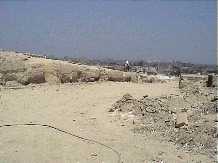
You have
turned to the right and are looking in an easterly
direction along the side of the causeway towards the
Sphinx. Note the power cable in the foreground.
|
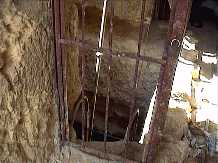
You have
walked into the south entrance. The shaft is on the west
side. Note the new-looking padlock, the water pipe
descending into the shaft (the top section looks almost
white because of reflection) and the top of the metal
ladder.
|
|
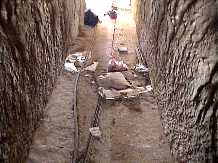
You have
walked further along the subway and turned around to
face the south entrance. The grill surrounding the shaft
can be seen at top centre. Note the various utility
services running along the floor.
|
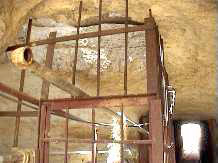
You are now
back at the padlocked gate. The north entrance can be
seen bottom right. Looking up, you can see light
entering from the causeway surface. Note the
disconnected water pipe in the foreground.
|
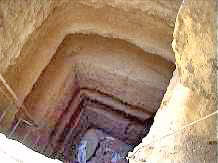
You have
walked past the shaft and turned around to look down it.
The metal ladder can be seen at left descending into the
shaft with the waterpipe to the left of the ladder. The
horizontal openings in the shaft wall do not continue
for any distance. Note the rope or cable on the right.
|
|
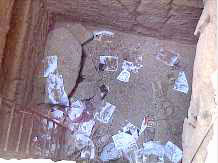
You are
looking closely at the bottom of the shaft. The entrance
to the first chamber can be seen leading away from the
right (north) wall. Discarded rope or cable can be seen
on the floor. |
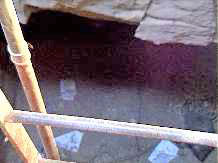
You are
looking into the entrance to the first chamber on its
south side. The second vertical shaft is located at the
northern end of the chamber
.
|
Go Back
Hassan's Description - A Lucky Find...
On returning to the U.K. in February 1998, I visited the Egypt
Exploration Society library as part of the search for a copy of
"Excavations At Giza." Unfortunately, it did not possess volumes 6
to 10 but while thumbing through volume 5 for no particular reason,
I came across a reference to the subway and the shaft under the
heading "Shafts Of The Saitic Period." It states:
"During this period, it was the
custom for well-to-do persons to cut for themselves very wide
and deep shafts ending in a spacious hall out of which opened a
series of small chambers, each containing a sarcophagus...
Sometimes the shaft is cut abnormally deep and in this case it
is divided into stages as it descends. The most striking example
of this type of shaft is that which was cut in the causeway of
the Second Pyramid and discovered by me in our sixth season's
work. [italics mine] Upon the surface of the causeway, they
first built a platform in the shape of a mastaba, using stones
taken from the ruins of the covered corridor of the causeway. In
the centre of this superstructure they sank a shaft which passed
through the roof and floor of the subway running under the
causeway to a depth of about 9.00m.
At the bottom of this shaft is a
rectangular chamber, in the floor of the eastern side of which
is another shaft. This descends about 14.00m and terminates in a
spacious hall surrounded by seven burial chambers in each of
which is a sarcophagus. two of these sarcophagi, which are of
basalt and are monolithic, are so enormous that at first we
wondered if they contained the bodies of sacred bulls.In the
eastern side of this hall is yet another shaft, about 10.00m
deep, but unfortunately it is flooded. Through the clear water
we can see that it ends in a colonnaded hall, also having side
chambers containing sarcophagi. We tried in vain to pump out the
water, but it seems that a spring must have broken through the
rock, for continual daily pumping over a period of four years
was unable to reduce the water level..."
(excerpted from "Excavations At Giza
Vol. 5 1933-1934" by Selim Hassan with the collaboration of Mahmoud
Darwish, Cairo Government Press, Bulaq 1944, page193)
The description above is certainly very similar to the description
in the appendix to H. Spencer Lewis's book but differences in
interpretation are clear. Hassan is talking about a shaft tomb of
the twenty sixth dynasty whereas Spencer Lewis suggests that it may
well have been connected with an ancient mystery school and could
possibly indicate the existence of other as yet undiscovered
passages in the vicinity.
I was convinced that if I could locate a copy of Volume 6, Dr Hassan
was sure to have fully documented the find complete with a plan of
the layout. I am indebted to Dr David Jeffreys of University
College, London for pointing me in the direction of The Griffith
Institute, Oxford, and to Dr John Spencer for allowing me to visit
the library one Saturday morning. The site excavation plan in volume
6 clearly shows the position of the subway under the causeway and
confirms that it was excavated during the sixth season.
Unfortunately, I could not find a single mention of the subway or
the shaft and its chambers. The extensive descriptions dealt only
with the excavation of the Old kingdom tombs to the south of the
causeway. Where to look next?
Go Back
|
 Back
in 1997, I came across a book first published in 1936 entitled "The
Symbolic Prophecy of the Great Pyramid" written by H. Spencer Lewis,
Ph.D., F.R.C. Until his death in 1939, Dr Lewis was the Imperator of
a modern-day mystery school known as the Rosicrucian Order, AMORC.
My interest was aroused by the appendix to the book which describes
an article written in the January 1935 edition of a magazine editted
in Egypt and "more or less privately published in London".
Back
in 1997, I came across a book first published in 1936 entitled "The
Symbolic Prophecy of the Great Pyramid" written by H. Spencer Lewis,
Ph.D., F.R.C. Until his death in 1939, Dr Lewis was the Imperator of
a modern-day mystery school known as the Rosicrucian Order, AMORC.
My interest was aroused by the appendix to the book which describes
an article written in the January 1935 edition of a magazine editted
in Egypt and "more or less privately published in London".





